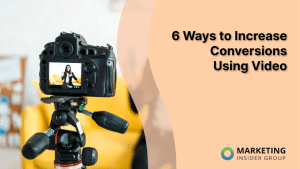
How we present and consume information is changing, and it’s up to marketing professionals to keep up with the trends. Content design is a relatively new concept that’s becoming vital to your marketing strategy as you look for ways to attract an audience.
The days of focusing on catchy headlines or attractive visuals are over. It’s all about creating content that truly resonates with audiences, combining strategic thinking, user-centricity, and creativity.
For marketers, mastering content design isn’t just a trend; it’s a game-changer. It ensures that every piece of content engages its intended viewers. Over 53% of engagement comes from organic search, so creating content your readers want to interact with is vital to your success.
This article will examine why content design deserves your focus and how to use this strategy to elevate your next marketing campaign.
Quick Takeaways
- Marketing is moving away from catchy headlines and attractive visuals toward content that resonates with audiences and solves their problems.
- Content design prioritizes the needs and preferences of the audience, leading to higher satisfaction and engagement.
- Implementing content design improves SEO, increases conversion rates, and enhances brand perception.
- The result is better content marketing outcomes and brand loyalty from consumers.
An Overview of Content Design
Content design is a modern approach to creating and organizing digital content that prioritizes the needs and experiences of the audience. At its core, content design is about crafting information in a way that is engaging and easy to understand. It’s more than words; it’s also how you structure and present the content.
Unlike traditional content creation, which often focuses solely on producing articles or blog posts, content design encompasses a broader spectrum. It integrates various disciplines, including user research, content strategy, and visual design, to ensure that every piece of content serves a clear purpose and meets user needs.
Key Elements of Content Design
- User Research: Understanding who the audience is, what they need, and how they interact with content. This research involves collecting data through surveys, interviews, and analytics to create detailed audience personas.
- Content Strategy: Planning how to develop and manage content effectively. Your content strategy includes determining what content types to produce, how they align with business goals, and the best distribution methods.
- Visual Design: Ensuring content is readable and visually appealing. Visual design uses images, videos, and infographics to enhance user engagement. It also includes layout and typography.
Content design ensures you optimize every piece of digital content for clarity, usability, and impact. It’s an essential practice for modern marketers looking to connect with their audience.
Why Content Design Matters
Content design is crucial because it influences how users experience and engage with digital content. Focusing on the needs and preferences of the audience ensures information is accessible, clear, and compelling.
When users find content easy to navigate and understand, their overall experience improves, leading to higher satisfaction and engagement.
Impact on User Experience and Engagement
Content design prioritizes a seamless and enjoyable experience for users. Users can quickly find the information they need and understand it. They are also more likely to interact with it as a result.
This positive interaction encourages them to spend more time on a website, explore more pages, and engage with calls to action, fostering a stronger connection with the brand.
Benefits for Marketers
Content design also aids your marketing efforts, helping you reach your goals by:
- Improving SEO: Well-designed content often ranks higher in search engine results because its structure is easy for search engines to understand and index. This increased visibility leads to more organic traffic and broader reach.
- Driving Higher Conversion Rates: Designing content with the user in mind guides them smoothly through their journey. It’s easier for them to take desired actions, such as purchasing or signing up for a newsletter. The result is higher conversion rates and better ROI on marketing efforts.
- Creating a Better Brand Perception: Consistent and thoughtfully designed content helps establish a brand’s credibility and authority. It shows the brand cares about its audience’s needs, which enhances trust and loyalty.
Content design is a thing because it enhances user experience and engagement, providing significant benefits for marketers. The resulting stronger SEO, higher conversion rates, and more positive brand perception are reasons enough to try content design.
Best Practices in Content Design
Your content design will likely differ for every piece of marketing material you create. However, following some best practices provides a guide as you build your online content.
Search Engine Optimization
SEO is vital in content design because it helps your content rank higher on search engines, making it more visible to your target audience. To optimize content for SEO, include:
- Keyword Integration: Identify relevant keywords through research and naturally incorporate them into your content, including in titles, headers, and throughout the text. Avoid keyword stuffing, as it can harm readability and SEO performance.
- Meta Descriptions: Write compelling meta descriptions that include your primary keywords. These descriptions appear in search results and can significantly influence click-through rates.
- Link Building: Use internal links to guide users to other relevant content on your site and external links to reputable sources. These links improve your content’s authority and relevance.
Make Disability-Friendly Content
Accessibility is critical to content design, ensuring all users, including those with disabilities, can access and interact with your content. Guidelines for creating accessible content include:
- Alt Text for Images: Provide descriptive alt text for images, allowing screen readers to convey the information to visually impaired users.
- Readability: Use clear, simple language and break content into short paragraphs. Utilize headings, bullet points, and ample white space to make content easier to read and navigate.
Focus on Mobile Content
Over 53% of online traffic comes from mobile devices, so optimizing content for them is essential. Strategies for mobile-friendly content design include:
- Responsive Design: Ensure your content adapts seamlessly to different screen sizes and orientations. Use flexible grids and images that scale correctly on various devices.
- Fast-Loading Times: Optimize images and other media for quick loading. Compress files and use efficient coding practices to reduce load times, improving user experience and SEO.
Create Brand Consistency Across Platforms
Consistency in content design reinforces your brand identity and builds trust with your audience. Tips for maintaining consistency include:
- A Cohesive Brand Voice: Develop a distinct brand voice and ensure it is used consistently across all content. Tone, style, and vocabulary are part of your brand voice.
- A Uniform Visual Style: Use consistent imagery, color schemes, and typography across all platforms. The result is a recognizable and professional appearance.
- Formatting: Standardize the structure and format of your content, including the use of headings, bullet points, and spacing. Consistent formatting makes your content more readable and professional.
These best practices will help you create content that is effective, engaging, and accessible. You can also be confident your content is optimized for search engines, mobile-friendly, and consistent across all platforms.
5 Content Design Steps
- Know Your Audience: Start by creating detailed profiles representing different segments of your audience. These personas should include demographic information, interests, pain points, and online behaviors. Use surveys, interviews, and analytics tools to gather this data.
- Research Keywords: Next, research keywords to find terms and phrases your audience uses when searching for information. Tools like Google Keyword Planner, Ahrefs, and SEMrush can help identify relevant keywords. Focus on a mix of short-tail and long-tail keywords to cover broad and specific queries.
- Evaluate Search Intent: Search intent refers to the reason behind a user’s query. Understanding search intent helps ensure your content matches users’ needs, improving relevance and engagement.
- Map Out Content: Create a map to organize and plan your content. A content map outlines each piece of content’s structure, flow, and purpose, ensuring a logical and intuitive arrangement. Begin by identifying the main topics and subtopics you want to cover. Then, arrange them in a way that guides users smoothly from one piece of content to the next.
- Create Engaging Design Assets: Visual elements are crucial in content design, making your content more appealing and easier to digest. Engaging design assets include infographics, videos, images, and interactive elements. These assets can break up text, illustrate complex ideas, and capture users’ attention.
Following these steps helps you create user-focused, well-organized, and visually engaging content. This approach will help you connect with your audience and achieve your marketing goals.
Designing Your Marketing Strategy
Content design helps arrange your marketing materials to encourage the reader to act. It guides your readers and viewers through the sales journey, pointing them in the right direction as you attempt to maximize sales.
Marketing Insider Group can put you on the right track with our Content Builder Services. Contact us for a free consultation with our team.







